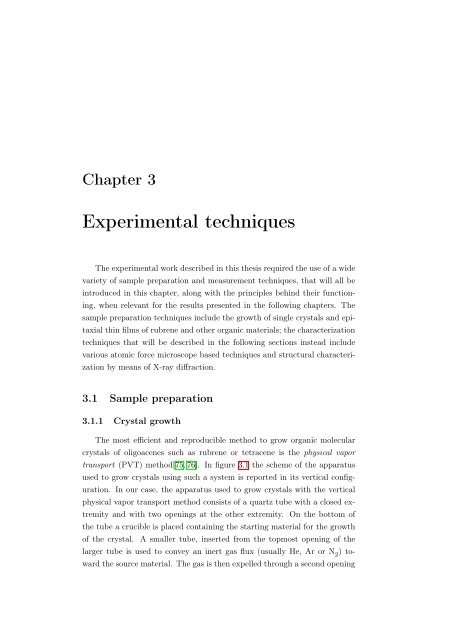Growth and physical properties of crystalline rubrene - BOA Bicocca ...
Growth and physical properties of crystalline rubrene - BOA Bicocca ...
Growth and physical properties of crystalline rubrene - BOA Bicocca ...
Create successful ePaper yourself
Turn your PDF publications into a flip-book with our unique Google optimized e-Paper software.
Chapter 3<br />
Experimental techniques<br />
The experimental work described in this thesis required the use <strong>of</strong> a wide<br />
variety <strong>of</strong> sample preparation <strong>and</strong> measurement techniques, that will all be<br />
introduced in this chapter, along with the principles behind their function-<br />
ing, when relevant for the results presented in the following chapters. The<br />
sample preparation techniques include the growth <strong>of</strong> single crystals <strong>and</strong> epi-<br />
taxial thin films <strong>of</strong> <strong>rubrene</strong> <strong>and</strong> other organic materials; the characterization<br />
techniques that will be described in the following sections instead include<br />
various atomic force microscope based techniques <strong>and</strong> structural characteri-<br />
zation by means <strong>of</strong> X-ray diffraction.<br />
3.1 Sample preparation<br />
3.1.1 Crystal growth<br />
The most efficient <strong>and</strong> reproducible method to grow organic molecular<br />
crystals <strong>of</strong> oligoacenes such as <strong>rubrene</strong> or tetracene is the <strong>physical</strong> vapor<br />
transport (PVT) method[75, 76]. In figure 3.1 the scheme <strong>of</strong> the apparatus<br />
used to grow crystals using such a system is reported in its vertical config-<br />
uration. In our case, the apparatus used to grow crystals with the vertical<br />
<strong>physical</strong> vapor transport method consists <strong>of</strong> a quartz tube with a closed ex-<br />
tremity <strong>and</strong> with two openings at the other extremity. On the bottom <strong>of</strong><br />
the tube a crucible is placed containing the starting material for the growth<br />
<strong>of</strong> the crystal. A smaller tube, inserted from the topmost opening <strong>of</strong> the<br />
larger tube is used to convey an inert gas flux (usually He, Ar or N 2 ) to-<br />
ward the source material. The gas is then expelled through a second opening

















